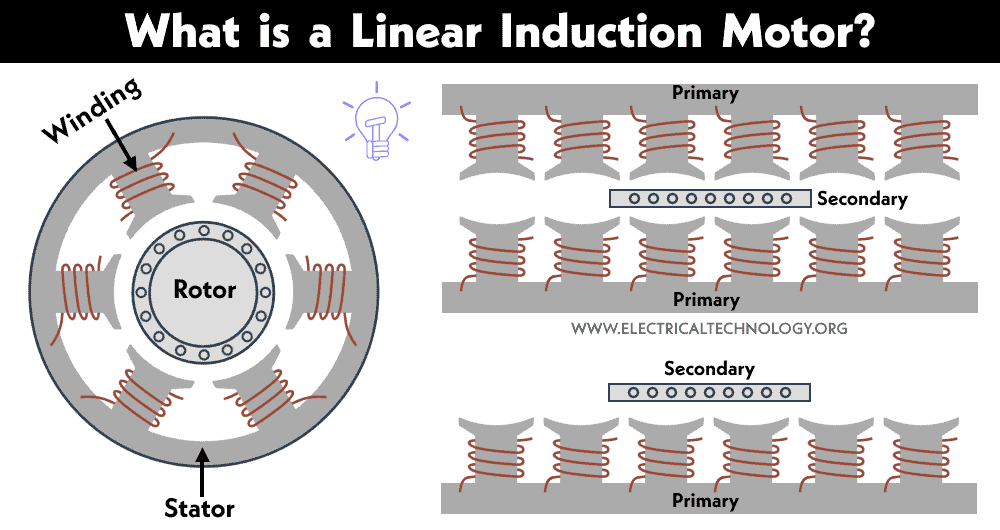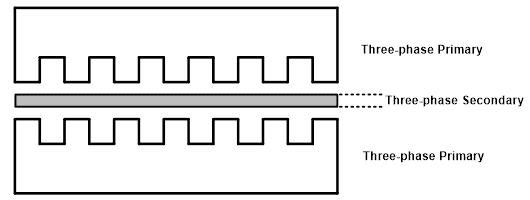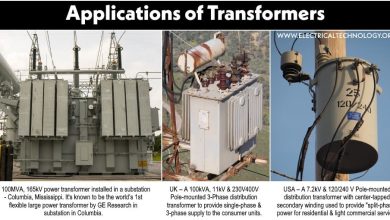What is a Linear Induction Motor “LIM”? Working Principle and Applications
Linear Induction Motor (LIM): Operating Principle, Classification, Performance, Advantages, Disadvantages and Applications
What is a Linear Induction Motor?
The induction motor is used to convert the electrical energy into rotation energy. Another form of induction motor is a linear induction motor. It is used to convert electrical energy into linear motion.
The linear induction motor is known as LIM. It operates on the principle of electromagnetic induction. This type of motor is most popular in traction applications. Similar to the regular induction motor, the linear induction motor also has two windings; primary winding and secondary winding. In most cases, the primary winding is made up of copper and the secondary winding is made up of aluminum.
The three-phase induction motor produces linear progressive motion and the single-phase induction motor produces oscillatory motion.
Operating Principle of Linear Induction Motor
The working principle of a linear induction motor is the same as the working principle of a conventional induction motor. The principle is that “when the relative motions occur between the field and the short-circuit conductors, currents are induced in the conductor. The current-carrying conductor produces EMF (electro-motive force), and due to this force, the conductor tries to move in such a way to eliminate the induced current (according to Lenz’s law).
In a regular induction motor, an induced magnetic field is rotating in nature. Hence, the movement in a conductor is also rotating. But in the case of a linear induction motor, the movement of a field is rectilinear. Hence, the movement of a conductor is linear.
When a three-phase supply is connected to the primary winding, a traveling flux is produced. This flux travels along the length of the primary part and induces EMF in the secondary. This EMF circulates currents in the secondary. This induced current interacts with traveling flux and produces force.
If one part (primary or secondary) is the fixed and the second part (secondary or primary) can move, then force will be produced on the moving member.
- Related Post: Linear Variable Differential Transformer
Traction Locomotive using LIM
If the primary winding is fixed and the secondary is movable, the force or thrust generates in the same direction as the traveling wave. Similarly, if the secondary winding is fixed and the primary winding is movable, the force or thrust generates in the opposite direction of the traveling wave.
The below figure shows the traction locomotive with moving primary and fixed secondary.
With the help of a pantograph, a single-phase supply is collected from the overhead conductor. This single-phase supply is converted into a three-phase supply using a converter. Now, this three-phase supply is given to the primary winding of a three-phase linear induction motor.
Due to the three-phase supply in the primary winding, it produces traveling flux that links in the secondary winding and produces EMF.
This EMF circulates current in the secondary winding. And due to interaction with primary traveling flux and secondary current, thrust or force is produced on a locomotive and it starts propelling.
The equation of linear synchronous speed is;
VS = 2 τf … m/s
Related Post:
- Single-Phase Induction Motor – Construction, Working, Types & Applications
- Three-Phase Induction Motor – Construction, Working, Types & Applications
Classification of Linear Induction Motor
According to the construction, the linear induction motor is classified into two types;
- Single-sided LIM
- Double-sided LIM
Single-sided LIM
In a single-sided linear induction motor, one of two (primary or secondary) winding is fixed and the other is rotating. Therefore, single-sided LIM can be classified into two types;
Moving Primary and Fixed Secondary
As the name suggests, the primary winding is moving and the secondary winding is fixed. This type of motor has slots in the iron core of primary winding and its moving. The three-phase winding is placed in slots of the primary winding.
The below figure shows the constructional details of moving primary and fixed secondary type single-sided LIM.
The direction of motion is opposite to the direction of traveling flux.
Moving Secondary and Fixed Primary
In this type of single-sided motor, the primary winding is fixed and the secondary winding is moving. The slots are available in the primary winding and a three-phase winding is placed.
The below figure shows the constructional details of moving secondary and fixed primary type single-sided LIM.
In this type of motor, the direction of motion is in the same direction of traveling flux.
Double-Sided LIM
Double-sided LIM is used for traction purposes. Especially, the moving primary and fixed secondary construction are popular. The below figure shows the construction of a double-sided LIM. The below figure shows a constructional diagram of double-sided LIM.
When the required movement is similar the distance between the two limits is shorter than the primary is made longer than the secondary.
When the distance is larger than primary is made shorter than secondary.
The double-sided linear induction motor gives better magnetic properties and the force obtained in this motor is more. The power factor is better due to proper magnetic coupling (compared to single-sided LIM). But the cost of this motor is more.
Related Posts:
- Torque-Slip and Torque-Speed Characteristics of Induction Motor
- Speed Control of DC Motor – Voltage, Rheostatic & Flux Control Methods
Performance Parameter of LIM
When a three-phase balanced supply is connected to the primary winding, a linear moving magnetic field is produced. The field moves by a distance of two-pole pitches (2τ) in one cycle of supply frequency (f).
The synchronous speed of a linear induction motor is defined as;
VS = 2 τf … m/s
Where,
- τ = Pole pitch (m)
- f = Frequency (Hz)
Similar to a conventional induction motor, the primary moves in the opposite direction of a field with the fixed secondary field at a speed of V. Then the slip is defined as;
From the above equation, we can say that the synchronous speed is not dependent on the number of poles but it depends on the pole pitch.
Therefore, a change in speed is achieved by adjusting the pole pitch τ. And the thrust or force is defined as;
Where,
- P = Power supplied to the motor (W)
- Vs = Linear synchronous speed (m/s)
Active power Pm is defined as mechanical power and it is the power developed by the motor;
Pm = Pr (1 – s)
Similar to the conventional motor, the rotor efficiency is defined as;
Rotor Copper Loss = sPf
Due to more air gap, the magnetizing current is large and the power factor is poor. Therefore, the efficiency is very poor of this motor.
Related Post:
Advantages and Disadvantages of LIM
Advantages
The advantages of a linear induction motor are listed below.
- Low initial cost
- Low maintenance
- No overheating
- No limitation of maximum speed
- Power to weight ratio is better than the conventional induction motor
- Tractive effort does not depend on the speed
Disadvantages
The disadvantages of linear induction motors are listed below.
- Low power-factor
- Poor efficiency
- In a linear induction motor, the air gap is large compared to the conventional induction motor. Therefore, a large magnetizing current is produced.
- The cost of a rail fixed along the centerline of the track is very high.
- It causes difficulties at crossings and hence other provisions are needed for crossing.
Applications of Linear Induction Motors
The applications of linear induction motors are listed below.
- This type of motor is widely used as a traction motor.
- Metallic belt conveyers
- Sliding door operations
- For transportation (medium and high-speed vehicles)
- In railway yards for shunting
- Electromagnetic pumps
Related Posts:
- Types of Electric Motors – Classification of AC, DC & Special Motors
- Applications of Electric Motors
- Motor Starter – Types of Motor Starters and Motor Starting Methods
- Direct Online Starter – DOL Starter Wiring Diagram for Motors
- Cable Size Calculation for LT & HT Motors
- Speed Control Methods of of a DC Motor
- DC Machine – Construction, Working, Types and Applications
- Servo Motor – Types, Construction, Working, Controlling & Applications
- Brushless DC Motor (BLDC) – Construction, Working Principle & Applications
- Stepper Motor – Types, Construction, Operation & Applications
- What is Motor Efficiency and How to improve it?
- Induction Motor & Linear Induction Motors Formulas & Equations
- What is Motor Generator Set and How Does it Work?
- How to Run a Three-Phase Induction Motor on a Single-Phase Power Supply?
- Electrical & Electronics Engineering Formulas & Equations
- Electric Motors Symbols
















